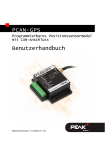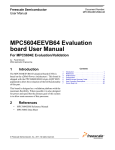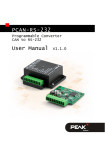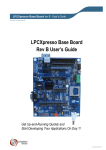Download PCAN-GPS - User Manual - PEAK
Transcript
PCAN-GPS Programmable Position Sensor Module with CAN Connection User Manual Document version 1.1.0 (2014-11-13) PCAN-GPS – User Manual Products taken into account Product Name Model Part number PCAN-GPS IPEH-002110 microSD™ is a trademark or registered trademark of SD-3C, LLC in the United States of America, other countries, or both. Other product names mentioned in this document may be the trademarks or registered trademarks of their respective companies. They are not explicitly marked by “™” and “®”. © 2014 PEAK-System Technik GmbH PEAK-System Technik GmbH Otto-Roehm-Strasse 69 64293 Darmstadt Germany Phone: +49 (0)6151 8173-20 Fax: +49 (0)6151 8173-29 www.peak-system.com [email protected] Document version 1.1.0 (2014-11-13) 2 PCAN-GPS – User Manual Contents 1 1.1 1.2 1.3 2 2.1 2.2 2.3 3 3.1 3.2 4 4.1 4.2 4.3 5 5.1 5.2 6 6.1 6.2 6.3 Introduction 5 Properties at a Glance Scope of Supply Prerequisites for Operation Description of the Sensors Receiver for Navigation Satellites (GNSS) Gyroscope Acceleration and Magnetic Field Sensor Hardware Configuration 5 6 7 8 8 9 10 13 Coding Solder Jumpers Buffer Battery for GNSS Connectors 14 15 16 Screw Terminal Strip SMA Antenna Connector microSD™ Slot (internal) Operation 16 17 17 18 Starting PCAN-GPS Status LEDs 18 18 Software 19 Installing the GNU ARM Toolchain Library Firmware Examples (Compiling) 3 19 20 20 PCAN-GPS – User Manual 7 7.1 7.2 7.3 8 Firmware Update 22 System Requirements Preparing Hardware and Software Sending the Firmware Technical Specifications 22 22 23 27 Appendix A CE Certificate 31 Appendix B Dimension Drawing 32 Appendix C CAN-Messages of the Demo Firmware 33 C.1 C.2 CAN Messages from the PCAN-GPS CAN Messages to the PCAN-GPS Appendix D Data Sheets 33 36 38 4 PCAN-GPS – User Manual 1 Introduction The PCAN-GPS is a programmable sensor module for position and orientation determination. It has a satellite receiver, a magnetic field sensor, an accelerometer, and a gyroscope. The sampled data can be transmitted on a CAN bus and logged on the internal memory card. The data processing is performed by a microcontroller of the NXP LPC4000 series. Using the supplied library and the Yagarto GNU ARM toolchain (contains the GNU Compiler Collection GCC for C and C++), custom firmware can be created and then transferred to the module via CAN. This gives a whole range of options for processing and routing of the arising sensor data. On delivery, the PCAN-GPS is provided with a demo firmware that transmits the raw data of the sensors periodically on the CAN bus. The source code of the demo firmware as well as further programming examples that cover different tasks are in the scope of supply. 1.1 Properties at a Glance NXP LPC4000 series microcontroller (ARM Cortex-M4) Receiver for navigation satellites u-blox MAX-7W (GPS, Galileo, GLONASS, QZSS, and SBAS) Bosch BMC050 electronic three-axis magnetic field sensor and three-axis accelerometer Gyroscope STMicroelectronics L3GD20 High-speed CAN channel (ISO 11898-2) with bit rates from 40 kbit/s to 1 Mbit/s 2-KByte EEPROM in the microcontroller 5 PCAN-GPS – User Manual Internal microSD™ memory card slot, e.g. for logging position data (microSD™ memory card not in the scope of supply) Wake-up via CAN bus or a separate input 2 digital inputs (High-active) 1 digital output (Low-side switch) LEDs for status signaling Connection via a 10-pole screw terminal strip (Phoenix) Supply voltage from 8 to 30 V Extended operating temperature range from -40 to +85 °C (-40 to +185 °F) (with exception of the button cell) New firmware can be loaded via CAN interface 1.2 Scope of Supply PCAN-GPS in a plastic casing 10-pin screw terminal strip External antenna for satellite reception Windows development software (Yagarto GNU ARM toolchain, flash program) DVD with library, programming examples, and manual in PDF format 6 PCAN-GPS – User Manual 1.3 Prerequisites for Operation Power supply in the range of 8 to 30 V DC For updating the firmware via CAN: • CAN interface of the PCAN series for the computer (e.g. PCAN-USB) • Operating system Windows 8.1, 7, Vista (32/64-bit) 7 PCAN-GPS – User Manual 2 Description of the Sensors This chapter describes the characteristics of the sensors that are used in the PCAN-GPS in short form and gives instructions for use. For additional information about the sensors, see the technical specifications (on page 27) and the data sheets of the respective manufacturers (Appendix D on page 38). 2.1 Receiver for Navigation Satellites (GNSS) The u-blox MAX-7W receiver is designed for the following global navigation satellite systems (GNSS): GPS (USA) GLONASS (Russia) Galileo (Europe) QZSS (Japan) SBAS (supplementary) To receive a satellite signal, an external antenna must be connected to the SMA socket . Both passive and active antennas are suitable. An active antenna is included. The use of GPS and GLONASS cannot happen simultaneously. On the one hand, the external antenna must match the respective system (the supplied one can receive both), on the other hand, the GNSS receiver must be switched. For a faster position fix after turning on the PCAN-GPS, the internal RTC and the internal backup RAM can be supplied by the button 8 PCAN-GPS – User Manual cell. This requires a hardware modification (see section 3.2 on page 15). 2.2 Gyroscope The STMicroelectronics L3GD20 gyroscope is a three-axis angular rate sensor. It returns the rotational speed around X, Y, and Z axis. X: roll Y: pitch Z: yaw Gyroscope axes in relation to the PCAN-GPS casing The covered rotation angle can be determined by integration over time. There are two sensor-internal filters for limitation and damping of output values. They are implemented by configurable high-pass and low-pass. With its cut-off frequency ( 3 dB level), the high-pass defines the minimum angular velocity needed for transmission. With the lowpass in contrast, it is possible to affect the transmission of faster rotation angles. Typical values for output can be distinguished from intermittent fast movements. The selected filter characteristic is always to be considered together with the output data rate (ODR). 9 PCAN-GPS – User Manual Filter curve of high-pass and low-pass 2.3 Acceleration and Magnetic Field Sensor The acceleration and magnetic field sensor Bosch Sensortec BMC050 is used to determine the position in a magnetic field (such as the earth's magnetic field) and the acceleration along three axes. Axes of the acceleration and magnetic field sensor in relation to the PCAN-GPS casing There are three configurable control lines to adjust the function to the respective application: Data Ready MAG, Interrupt_MAG, and 10 PCAN-GPS – User Manual Interrupt_ACC1. Interrupt_ACC2 is not connected to the microcontroller. All connected interrupt lines of the sensor are provided with pull-up resistors. Since both functions of the sensor are independent of each other, also the corresponding interrupt functions are not linked. The interrupt for the acceleration sensor can be configured from seven functionalities, its timing validity can be adjusted. The functional scope of the magnetic field sensor interrupt comprises four sources. The offset compensation of the acceleration sensor is done via the addition of a correction value which is copied from the EEPROM. This requires a conversion of an 8-bit value (Public Register) to a 10bit value (Internal Register) (see table). With one of the four compensation methods, the correction value can be checked and readjusted. Bit in Public register Compensation value for measuring range ±2 G ±4 G ±8 G 8 (msb): sign ± ± ± ±16 G ± 7 500 mG 500 mG 500 mG 500 mG 6 250 mG 250 mG 250 mG 250 mG 5 125 mG 125 mG 125 mG 125 mG 4 62.5 mG 62.5 mG 62.5 mG 62.5 mG 3 31.3 mG 31.3 mG 31.3 mG 31.3 mG 2 15.6 mG 15.6 mG 15.6 mG - 1 (lsb) 7.8 mG 7.8 mG - - The correction value can be determined with four methods. A target value (± 1 G in X/Y/Z) is given in this process. The methods determine the necessary offset of the measured value until it reaches the target value. The offset appears in the Public Register and may be transferred to EEPROM. Slow compensation: Over several steps (8 or 16), the correction value is gradually adjusted (4 lsb) to reach the target value. 11 PCAN-GPS – User Manual Fast compensation: The correction value is calculated from the average of 16 measurements and the target value. Manual compensation: The user specifies a correction value. Inline calibration: The calculated correction value is stored in the EEPROM. 12 PCAN-GPS – User Manual 3 Hardware Configuration Basic settings can be made on the circuit board of the PCAN-GPS module by using solder jumpers. On delivery, there are the following presets: 3 coding solder jumpers: all open Buffer battery for satellite reception: not connected These settings need to be adjusted only if necessary. On delivery, you can operate the PCAN-GPS module without changing the hardware configuration. Attention! Electrostatic discharge (ESD) can damage or destroy components on the PCAN-GPS circuit board. Take precautions to avoid ESD when handling the circuit board. 13 PCAN-GPS – User Manual 3.1 Coding Solder Jumpers The three solder fields for coding solder jumpers (ID0, ID1, ID2) are each assigned to one port of the LPC4074 microcontroller (μC). Solder fields for coding solder jumpers on the circuit board Solder field is … Status at the port bridged Low open High The status of the ports is relevant in the following cases: The loaded firmware is programmed so that it reads the status at the corresponding ports of the microcontroller. For example, the activation of certain functions of the firmware or the coding of an ID is conceivable here. For a firmware update via CAN, the PCAN-GPS module is identified by a 3-bit ID which is determined by solder jumpers. A bit is set (1) when the corresponding solder field is open (default setting: ID 7, all solder fields open). 14 PCAN-GPS – User Manual Solder field ID0 ID1 ID2 Binary digit 001 010 100 1 2 4 Decimal equivalent See also chapter 7 Firmware Update on page 22. 3.2 Buffer Battery for GNSS The receiver for navigation satellites (GNSS) needs about half a minute until the first position fix after switching on the PCAN-GPS module. To shorten this period, the button cell can be used as a buffer battery for a quick start of the GNSS Receiver. However, this will shorten the life of the button cell. On solder field JP6, a solder bridge must be set that connects the button cell with the GNSS receiver. Solder field JP6 on the circuit board 15 PCAN-GPS – User Manual 4 Connectors 4.1 Screw Terminal Strip Screw terminal strip with 3.5 mm pitch (Phoenix Contact MC 1,5/10-ST-3,5 - 1840447) Terminal Identifier Function 1 Ub Power supply 8 - 30 V DC, e.g. car terminal 30, reverse-polarity protection 2 GND Ground 3 CAN_L 4 CAN_H 5 DOut Digital output, Low-side switch 6 DIn1 Digital input, High-active (internal pulldown), inverting Differential CAN signal 7 Boot CAN CAN bootloader activation, High-active 8 GND Ground 9 Wake-up External wake-up signal, High-active, e.g. car terminal 15 10 DIn2 Digital input, High-active (internal pulldown), inverting 16 PCAN-GPS – User Manual 4.2 SMA Antenna Connector An external antenna must be connected to the SMA socket for the reception of satellite signals. Both passive and active antennas are suitable. For an active antenna, a supply of 3.3 V with at most 50 mA can be switched through the GNSS receiver. The scope of supply of the PCAN-GPS provides an active antenna that is suitable for the navigation satellite systems GPS and GLONASS. 4.3 microSD™ Slot (internal) For the recording of, for example, status and location information, a microSD™ memory card of the types SD and SDHC can be used (not included). The maximum capacity is 32 GByte. Freely available source code exists for the implementation of the FAT32 file system in custom firmware. Note: The microSD™ connectivity in the PCAN-GPS module is not suitable for recording large data flows, such as the CAN traffic. In order to insert a memory card, open the casing of the PCAN-GPS module by loosening the two fixing screws. 17 PCAN-GPS – User Manual 5 Operation 5.1 Starting PCAN-GPS The PCAN-GPS is activated by applying the supply voltage to the respective ports (see chapter 4.1 Screw Terminal Strip on page 16). The firmware in the flash memory is subsequently run. At delivery, the PCAN-GPS is provided with a demo firmware. At a CAN bit rate of 500 kbit/s, it periodically transmits the raw values determined by the sensors. In Appendix C on page 33, there is a list of the used CAN messages. 5.2 Status LEDs The PCAN-GPS has two status LEDs that can be green, red, or orange. The status LEDs are controlled by the running firmware. If the PCAN-GPS module is in CAN bootloader mode which is used for a firmware update (see chapter 7 on page 22), the two LEDs are in the following state: Status 1 (left): orange, quickly blinking Status 2 (right): orange 18 PCAN-GPS – User Manual 6 Software This chapter covers the installation of the Yagarto GNU ARM toolchain and gives notes about the software library and the firmware examples. Software, source code, and additional information are included on the supplied DVD in the following directory branch: /Develop/Microcontroller hardware/PCAN-GPS/ 6.1 Installing the GNU ARM Toolchain To compile the code examples and the custom firmware code under Windows, install Yagarto on your computer. Yagarto is a collection of tools to develop applications for ARM processors and microcontrollers on Windows platforms. The collection includes the GNU GCC compiler for C and C++, Make, and further tools. Further information about Yagarto: www.yagarto.de System requirement: operating system Windows 8.1, 7, Vista (32/64-bit) Do the following to install Yagarto: 1. From the directory branch on the provided DVD mentioned above, change to the Compiler subdirectory. The directory contains the two installation programs yagarto-*.exe and yagarto-tools-*.exe. 2. Execute the first installation program and follow its instructions. 19 PCAN-GPS – User Manual If you don't want to use the default destination folder, make sure that your customized path doesn't contain any spaces. Otherwise compile operations will not work later. 3. Afterwards, execute the second installation program and follow its instructions. In the system environment, the installation programs create search paths for the executable files. These new search paths are effective only for programs and command prompts that are started afterwards. 6.2 Library The development of applications for the PCAN-GPS module is supported by the library libPCAN-GPS-GNU*.a (* stands for version number), a binary file. You can access the resources of the module by means of this library. The library is documented in the header files (*.h). The files are located in each example directory. 6.3 Firmware Examples (Compiling) On the DVD, the Examples subdirectory contains source code for several firmware examples that you can use and test directly and that you can reuse for custom firmware. At delivery, the PCAN-GPS module is provided with the DeliveryFirmware. At a CAN bit rate of 500 kbit/s, it periodically transmits the raw values determined by the sensors. In Appendix C on page 33, there is a list of the used CAN messages. Freely available source code exists for the implementation of the FAT32 file system in custom firmware. 20 PCAN-GPS – User Manual Do the following to compile a firmware example under Windows: 1. From the provided DVD, copy the subdirectory of the desired example from the Examples directory to the local hard disk. 2. Open a command prompt by using the Windows Start menu. Alternatively you can press the key combination á + R and enter cmd.exe as program to be executed. 3. At the command prompt change to the previously copied directory. 4. Execute the following command in order to clean-up the target directories (i.e. .out) from files that have been generated earlier: make clean 5. Execute the following command to compile the example firmware: make all If the compiler has finished without errors (“Errors: none”), you can find the firmware file with the extension .bin in the subdirectory .out. This file is then used for a firmware update on the PCAN-GPS module. 21 PCAN-GPS – User Manual 7 Firmware Update The microcontroller in the PCAN-GPS module is equipped with new firmware via CAN. The scope of supply includes the Windows program PCAN-Flash to transfer the firmware from the computer to the PCAN-GPS module. 7.1 System Requirements CAN interface of the PCAN series for the computer (e.g. PCANUSB) CAN cabling between the CAN interface and the PCAN-GPS module with proper termination (120 Ω on each end of the CAN bus) Operating system Windows 8.1, 7, Vista (32/64-bit) If you want to update several PCAN-GPS modules connected to the same CAN bus, you must assign a unique ID to each module. See section 3.1 Coding Solder Jumpers on page 14. 7.2 Preparing Hardware and Software Perform the following steps for preparation of the hardware: 1. Switch the off the PCAN-GPS module by disconnecting it from the power supply. 2. Establish a connection between “+Ub” (terminal 1) and “Boot CAN” (terminal 7) of the module. 22 PCAN-GPS – User Manual Connection at the screw terminal strip between terminals 1 and 7 This measure later applies the “Boot CAN” connection with a High level. 3. Connect the CAN bus of the module with a CAN interface connected to the computer. Pay attention to the proper termination of the CAN cabling (2 x 120 Ω). Perform the following steps for preparation of the software: 1. On the supplied DVD, change to the following directory: /Develop/Microcontroller hardware/PCAN-GPS/ 2. Copy the subdirectory PcanFlash to the local hard disk. The contained Windows software that copies the Firmware via CAN (PcanFlash.exe) can only be started from a data carrier that is writable. 7.3 Sending the Firmware The process of sending new firmware to the PCAN-GPS module is as follows: 1. Ensure that a connection is established between the “Ub” and the “Boot CAN” terminals of the module (details: see above). 2. Switch on the module by applying a supply voltage. 23 PCAN-GPS – User Manual Due to the High level at the “Boot CAN” connection, the module starts the CAN bootloader. This is indicated by the two LEDs: both orange, the left one quickly blinking. 3. Run the program PcanFlash.exe under Windows from the local hard drive. 4. Click on the box. 5. From the Hardware Profile dropdown list, select the PCANGPS entry. 6. Click on the … button next to the File name field in order to select the desired firmware file (*.bin) to be send. 7. Click on the OK button. (Options) button in order to call up the dialog 24 PCAN-GPS – User Manual 8. Make sure that the PCAN-Flash program is connected with 500 kbit/s to the available CAN interface at the computer. PCAN-Flash: Display of a connection in the status bar on the bottom. If not, click the (Connect) button in order to change the selection in the according dialog box. 9. Click the (Detect) button in order to detect the PCAN-GPS module connected to the CAN bus. An entry for the PCAN-GPS module appears in the main window. 25 PCAN-GPS – User Manual 10. Select the entry for the PCAN-GPS module. 11. Click the (Program) button in order to start sending the new firmware to the converter. Observe the status indication at the bottom of the window. The process was successful if the last message to appear is “Flashing of module(s) finished!”. 12. Disconnect the power supply from the module. 13. At the module, disconnect “Boot CAN” from “Ub”. You can now use the PCAN-GPS module with the new firmware. 26 PCAN-GPS – User Manual 8 Technical Specifications Power supply Supply voltage 8 - 30 V DC Current consumption normal operation 8 V: 100 mA 12 V: 60 mA 24 V: 30 mA 30 V: 25 mA Current consumption sleep 60 μA Button cell for RTC (and GNSS if required) 3 V, type CR2032 Note: Observe the operating temperature range for used button cell. Connectors Screw terminal strip 10-pole, 3.5 mm pitch (Phoenix Contact MC 1,5/10-ST-3,5 - 1840447) Antenna Sub-Miniature-A (SMA) Supply for activa antenna: 3.3 V, max. 50 mA Memory card micoSD™ slot internally for cards up to 32 GByte, types SD and SDHC CAN Specification ISO 11898-2, High-speed CAN 2.0A (Standard format) and 2.0B (Extended format) Bit rates 40 kbit/s - 1 Mbit/s Transceiver NXP TJA1041T, wake-up-capable Termination none 27 PCAN-GPS – User Manual Receiver for navigation satellites (GNSS) Type u-blox MAX-7W Receivable navigation systems 1 GPS, GLONASS, Galileo, QZSS, SBAS Connection to microcontroller Serial connection (UART 2) with 9600 Baud 8N1 (default) Input for synchronization pulses (ExtInt) Output of timing pulses (default: 1/s) Operating modes Continuous Mode Power-save Mode Antenna type active or passive Protective circuit antenna Monitoring of the antenna current on short circuit with error message Maximum update rate of navigation data 10 Hz Maximum number of satellites received at the same time 56 Sensitivity max. -161 dbm (tracking and navigation) Time to first position fix after cold start (TTFF) about 30 s Accuracy of the position values GPS: 2.5 m GPS with SBAS: 2 m GLONASS: 4 m Supply for active antenna 3.3 V, max. 50 mA, switchable Antenna for satellite reception Type 1 taoglas Ulysses AA.162 Center frequency range 1574 - 1610 MHz Operating temperature range -40 - +85 °C (-40 - +185 °F) Size 40 x 38 x 10 mm Cable length about 3 m Weight 59 g Special feature Integrated magnet for mounting The demo firmware uses GPS. 28 PCAN-GPS – User Manual Gyroscope Type STMicroelectronics L3GD20 Connection to microcontroller SPI Axes roll (X), pitch (Y), yaw (Z) Measuring ranges ±250, ±500, ±2000 dps (degrees per second) Data format 16 bits, two's complement Output data rate (ODR) 95 Hz, 190 Hz, 380 Hz, 760 Hz Filter possibilities Configurable high-pass and low-pass Power saving modes Sleep (2 mA), Power-down (5 μA) Acceleration and magnetic field sensor Type Bosch Sensortec BMC050 Connection to microcontroller SPI Accelerometer Measuring ranges ±2/±4/±8/±16 G Data format 10 bits, two's complement Filter possibilities Low-pass with 1 kHz - 8 Hz bandwidth Operating modes Power off, Normal, Suspend, Low-Power Correction options Offset compensation Magnetic field sensor Sensitivity X, Y: ±1000 μT Z: ±2500 μT Data format X, Y: 13 bits, two's complement Z: 15 bits, two's complement Output data rate (ODR) 2 - 30 measurements per second Operating modes Power off, Suspend, Sleep, Active Digital inputs Count 2 (terminals 6 and 10) Switch type High-active (internal pull-down), inverting Max. input frequency 3 kHz Switching thresholds High: Uin ≥ 3 V Low: Uin ≤ 2.2 V Internal resistance 133 kΩ 29 PCAN-GPS – User Manual Digital output Count 1 (terminal 5) Type Low-side driver Max. voltage 30 V Max. current 0.5 A Short-circuit current 1.5 A Microcontroller Type NXP LPC4074 Clock frequency quartz 12 MHz Clock frequency internally max. 120 MHz (programmable by PLL) Measures Size 45 x 68 x 26 mm (without SMA connector) See also dimension drawing Appendix B on page 32 Weight Circuit board: 33 g (incl. button cell and mating connector) Casing: 17 g Environment Operating temperature -40 - +85 °C (-40 to +185 °F) (except button cell) Button cell (typical): -20 - +60 °C (-5 to +140 °F) Temperature for storage and transport -40 - +85 °C (-40 to +185 °F) (except button cell) Button cell (typical): -40 - +70 °C (-40 to +160 °F) Relative humidity 15 - 90 %, not condensing EMC EN 61326-1:2013-07 EC directive 2004/108/EG Ingress protection (IEC 60529) IP20 30 PCAN-GPS – User Manual Appendix A CE Certificate 31 PCAN-GPS – User Manual Appendix B Dimension Drawing The dimension drawing is not shown in actual size. 32 PCAN-GPS – User Manual Appendix C CAN-Messages of the Demo Firmware The two tables apply to the demo firmware which is provided with the PCAN-GPS at delivery. They list the CAN messages that, on the one hand, are transmitted periodically by the PCAN-GPS (600h to 640h) and, on the other hand, can be used to control the PCAN-GPS (650h to 657h). Tip: For users of the PCAN-Explorer 5, the provided DVD contains an example project suitable for the demo firmware in the following directory branch: /Develop/Microcontroller hardware/PCAN-GPS/ C.1 CAN Messages from the PCAN-GPS CAN ID Start bit Bit count Identifier Values 600h BMC_Acceleration 0 16 Acceleration_X 16 16 Acceleration_Y 32 16 Acceleration_Z 48 8 Temperature Conversion to °C: raw value * 0.5 + 24 56 2 VerticalAxis 0 = undefined 1 = X Axis 2 = Y Axis 3 = Z Axis 58 3 Orientation 0 = flat 1 = flat upside down 2 = landscape left 3 = landscape right 4 = portrait 5 = portrait upside down Conversion to mG: raw value * 3.91 33 PCAN-GPS – User Manual CAN ID Start bit Bit count Identifier Values 601h BMC_MagneticField 0 16 MagneticField_X 16 16 MagneticField_Y 32 16 MagneticField_Z Conversion to μT: raw value * 0.3 610h L3GD20_Rotation_A 0 32 Rotation_X 32 32 Rotation_Y Floating-point number 2, unit: degree per second 611h L3GD20_Rotation_B 0 32 Rotation_Z Floating-point number2, unit: degree per second GPS_AntennaStatus 0 = INIT 1 = DONTKNOW 2 = OK 3 = SHORT 4 = OPEN 620h GPS_Status 0 8 8 8 GPS_NumSatellites 16 8 GPS_NavigationMethod 0 = INIT 1 = NONE 2 = 2D 3 = 3D 621h GPS_CourseSpeed 0 32 GPS_Course Floating-point number2, unit: degree 32 32 GPS_Speed Floating-point number2, unit: km/h 622h GPS_PositionLongitude 2 0 32 GPS_Longitude_Minutes 32 16 GPS_Longitude_Degree 48 8 GPS_IndicatorEW Floating-point number2 0 = INIT 69 = East 87 = West Sign: 1 bit, fixed-point part: 23 bits, exponent: 8 bits (according to IEEE 754) 34 PCAN-GPS – User Manual CAN ID Start bit Bit count Identifier Values 623h GPS_PositionLatitude 0 32 GPS_Latitude_Minutes 32 16 GPS_Latitude_Degree 48 8 GPS_IndicatorNS Floating-point number2 0 = INIT 78 = North 83 = South 624h GPS_PositionAltitude 0 32 Floating-point number2 GPS_Altitude 625h GPS_Delusions_A 0 32 GPS_PDOP 32 32 GPS_HDOP Floating-point number2 626h GPS_Delusions_B 0 32 Floating-point number2 GPS_VDOP 627h GPS_DateTime 0 8 UTC_Year 8 8 UTC_Month 16 8 UTC_DayOfMonth 24 8 UTC_Hour 32 8 UTC_Minute 40 8 UTC_Second 0 1 Din1_Status 1 1 Din2_Status 2 1 Dout_Status 3 1 SD_Present 4 1 GPS_PowerStatus 5 3 Device_ID 630h IO 35 PCAN-GPS – User Manual CAN ID Start bit Bit count Identifier Values 640h RTC_DateTime 0 8 RTC_Sec 8 8 RTC_Min 16 8 RTC_Hour 24 8 RTC_DayOfWeek 32 8 RTC_DayOfMonth 40 8 RTC_Month 48 16 RTC_Year C.2 0 = Monday 1 = Tuesday 2 = Wednesday 3 = Thursday 4 = Friday 5 = Saturday 6 = Sunday CAN Messages to the PCAN-GPS CAN ID Start bit Bit count Identifier Values 650h Out_IO (1 byte) 0 1 Dout_Set 1 1 GPS_SetPower 651h Out_PowerOff (1 byte) 0 1 Device_PowerOff 652h Out_Gyro (1 byte) 0 2 Gyro_SetScale 0 = ±250 °/s 1 = ±500 °/s 2 = ±2000 °/s 653h Out_BMC_AccScale (1 byte) 0 3 Acc_SetScale 1 = ±2 G 2 = ±4 G 3 = ±8 G 4 = ±16 G 36 PCAN-GPS – User Manual CAN ID Start bit Bit count Identifier Values 654h Out_SaveConfig (1 byte) 0 1 Config_SaveToEEPROM 655h Out_RTC_SetTime (8 bytes) 0 8 RTC_SetSec 8 8 RTC_SetMin 16 8 RTC_SetHour 24 8 RTC_SetDayOfWeek 32 8 RTC_SetDayOfMonth 40 8 RTC_SetMonth 48 16 RTC_SetYear 0 = Monday 1 = Tuesday 2 = Wednesday 3 = Thursday 4 = Friday 5 = Saturday 6 = Sunday 656h Out_RTC_TimeFromGPS (1 byte) 0 1 RTC_SetTimeFromGPS Note: The data from GPS does not contain the day of week. 657h Out_Acc_FastCalibration (4 bytes) 0 2 Acc_SetCalibTarget_X 8 2 Acc_SetCalibTarget_Y 16 2 Acc_SetCalibTarget_Z 24 1 Acc_StartFastCalib 37 0=0G 1 = +1 G 2 = -1 G PCAN-GPS – User Manual Appendix D Data Sheets The data sheets of components of the PCAN-GPS are enclosed to this document (PDF files). You can download the current versions of the data sheets and additional information from the manufacturer websites. Antenna taoglas Ulysses AA.162: PCAN-GPS_UserManAppendix_Antenna.pdf www.taoglas.com GNSS receiver u-blox MAX-7W: PCAN-GPS_UserManAppendix_GNSS.pdf www.u-blox.com Gyroscope STMicroelectronics L3GD20: PCAN-GPS_UserManAppendix_Gyroscope.pdf www.st.com Acceleration and magnetic field sesnor Bosch Sensortec BMC050: PCAN-GPS_UserManAppendix_MagneticFieldSensor.pdf www.bosch-sensortec.com Microcontroller NXP LPC4074 (User Manual): PCAN-GPS_UserManAppendix_Microcontroller.pdf www.nxp.com 38



















































